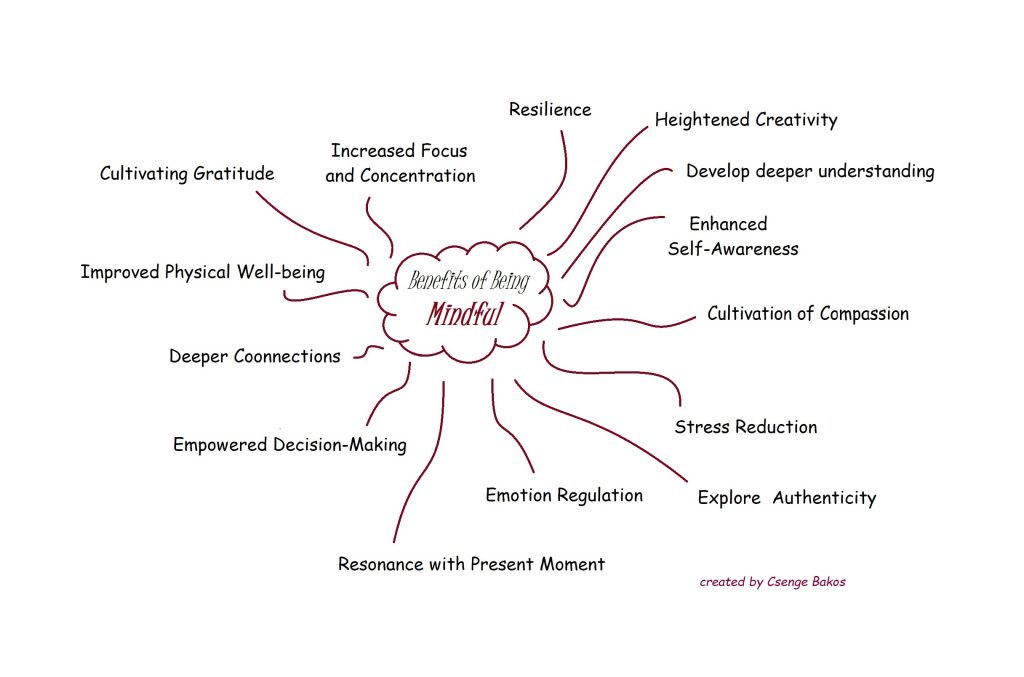Mindfulness, also known as the technique of conscious presence, has evolved from the roots of a more than 2,500-year-old Buddhist meditation practice. It is very important that the conscious experience of the present moment happens with loving kindness, without labeling and judgment. This is a method that allows us to develop skills to handle difficult feelings in a balanced way, without amplifying or avoiding them.
What simple mindfulness techniques can we apply?
Any technique that helps us focus our attention on the present moment. Observing our breathing is the easiest to apply. We observe how long our inhalation and exhalation last, where we take the air (into our chest or belly), and through what (through our nose or mouth) for a few breaths. It immediately brings our focus to the present moment. It is also an easy to use technique to observe our environment or our own body, thoughts and emotions. It is important to emphasize that all observations are done with loving thoughts, without labelling and judgment. In addition, it also includes relaxation, meditation, and visualization techniques.

Ezek a megoldások csak példák. Mindenkinek más igényei, prioritásai és problémái vannak. Ami valakinek segít, nem feltétlenül fog működni másnak. Kisérletezz, hogy neked mi segít, és ne aggódj ha ez egyéni.
- Observation of breathing: After waking up we can start our day with observing our breathing in the bed, instead of checking our phone.
- Observing our physical feeling: When consuming our morning drink, we can focus our attention on how we do it. How our mouth touches the glass, how cold/warm liquid goes through our esophagus.
- Observing our feelings: During our meal, instead of scrolling on our phone, consider to check in with our own, present feelings. It is very important to do it without labeling or judging them. For example: “I am
exhausted. Hello, exhaustion, sit with me.” And just observe and feel. If we feel like it starts to get a hang of us, pull us in, let’s just take a few deep breaths. - Observing our actions: If you try brushing your teeth with the other hand, because of the unfamiliar action, your your attention will be on the tooth brushing, staying in the present.
The importance of mindfulness
The importance of practicing mindfulness techniques cannot be overstated, especially in today’s fast-paced, digitally-driven world. Many are immersed in distractions, anxiety and lack of self-confidence. Mindfulness serves as an anchor that provides a stable foundation for people to face the challenges of today’s chaotic life. That is why it is important to set aside time for it in our daily lives.
If someone has never consciously practiced mindfulness techniques, it can be difficult to in the beginning. It is important that we do it with achievable steps in, so that we don’t create an “Oh no, I failed again” or “My thoughts are simply dragging me away” mentality. If these happens, no worries. Take a few deep breaths (I’m sure this is something everyone can successfully do) and simply say out loud, “Now I’m thinking about the afternoon conference” and let go and return to focusing on our breathing. Another thing that can help is to set aside time with a 2-minute timer on our phone – with a pleasant chime so we don’t jump out of our skin when it goes off – and only do any of the mindfulness techniques for that duration.
I wish everyone persistent mindfulness practice!
- Kabat-Zinn, J. (2003). Mindfulness-based interventions in context: Past, present, and future. Clinical Psychology: Science and Practice, 10 (2), 144–156. https://doi.org/10.1093/clipsy.bpg016
- Hofmann, S. G., Sawyer, A. T., Witt, A. A., & Oh, D. (2010). The effect of mindfulness-based therapy on anxiety and depression: A meta-analytic review. Journal of Consulting and Clinical Psychology, 78 (2), 169–183. https://doi.org/10.1037/a0018555
- Shapiro, S. L., Carlson, L. E., Astin, J. A., & Freedman, B. (2006). Mechanisms of mindfulness. Journal of Clinical Psychology, 62 (3), 373–386. https://doi.org/10.1002/jclp.20237





